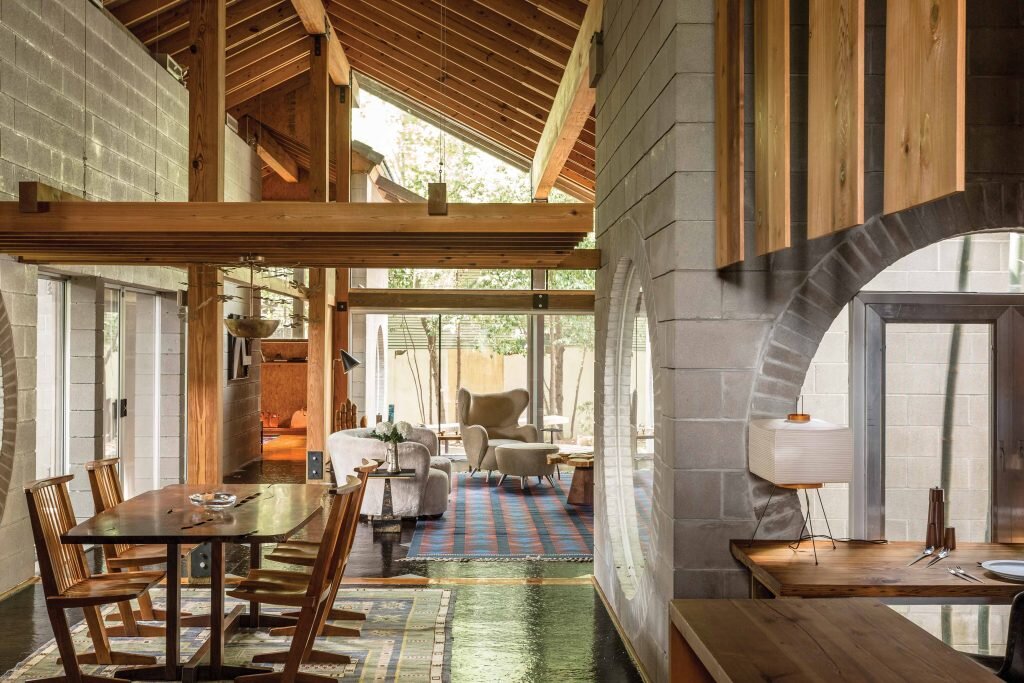
Montrose’s Houses of the Future
Legendary Houston Professor Leaves a Unique Impact Post Death
BY CATHERINE D. ANSPON // 02.15.17
PHOTOGRAPHY MAX BURKHALTER
Gaea II served as a showcase for Professor Zemanek’s utopian ideals, whose social justice component is in keeping with current times. The home today also functions as a private gallery for The Exchange Int. Six-figure Paavo Tynell Snowflake hanging chandelier. Barkley hopes to write a volume about the late Finnish lighting innovator whose auction record has soared to $198,000. The religious scene is by an unknown Mexican artist; dated 1957, it hints at influence from the Mexican muralists.
An architect is like an artist: After they die, their work remains, so an intrinsic something of them lives on. In the case of late Houston architect John Zemanek, perhaps his most visible legacy — besides the hundreds of students he inspired during his half-century as a professor at University of Houston — are the three homes he designed as personal dwellings.
Each is in Houston, conceived as part of an ongoing series, a case-study house so to speak, on how to live in America in the late 20th and early 21st centuries. The homes are named Gaea I, II, and III after the primal Greek goddess of Mother Earth.
Each of the houses, all still standing in Montrose, espouses Zemanek’s unique philosophy, which interweaves influences that would mold his life and avocation as an architect.








These begin with his childhood in rural Fort Bend County; he was the youngest of 12 children of Moravian immigrants who arrived in 1897 at the Port of Galveston seeking political asylum. He earned degrees from Texas A&M, the University of Texas, and Harvard — the latter, an improbable place for a Texas farm boy but where he matriculated thanks to the GI Bill and his service in World War II as a bombardier who survived 39 missions, capped by being shot down in enemy lines on the final day of combat.
At Harvard, he found inspiration and earned a Master of City Planning in the Graduate School of Design while studying with professors such as Bauhaus master Walter Gropius. Finally, there was a transformative stint designing American airbases in post-World War II Japan, where his encounter with Japanese architecture, from the domestic to Shinto shrines, would become a foundation of his future practice. And that just gets you into the 1950s.
Zemanek was a revered professor, popular with the students at University of Houston, where he began teaching in 1962, brought on full-time in 1964. In 1968, at the height of the protest movement, his pending firing by the UH College of Architecture dean — for teaching the ideals rather than mere mechanics of architecture — prompted a student-body walkout and led to the dean stepping down.
In 1978, he earned the national AIA Honor Award for his sensitive design for the Three “H” Services Center, which served the Harris County community of Bordersville, an impoverished neighborhood on the outskirts of Houston established by former slaves.
Books could be written about Zemanek — and one recently has. His autobiography, Being••Becoming: An Acorn Is to Become an Oak, completed three months before he passed away last April at the age of 94, still active and designing.
His last project, the interior of Heights coffee shop Morningstar, bears his signature moon gate and use of unadorned building materials, a balance of functionality, affordability, and appropriateness with an organic dose of global architecture, emblematic of his entire practice.
For those who will now never have a chance to meet him, much of Zemanek is here on these pages, in Gaea II, a home he designed in the late 1990s/2000 and moved into in February 2001, as he approached 80. His third home, Gaea III, catty-corner and down the street, was his residence during his 90s, completed in 2011, and where he lived out his final, nonetheless significant chapter. After moving into Gaea III, rather than selling Gaea II, the architect leased it.
Filled Gaea II with impeccable museum-caliber furnishings and accessories from the American studio movement — particularly the extraordinary and intensely collected robust sculptural metal creations of Paul Evans — as well as international designers of the mid-century and beyond, many of whom Zemanek had known personally.
Today, Gaea II looks as good as it did when it was the architect’s own home, playing the architectural and design consciousness forward. It continues to quietly attract attention from the like-minded. The temple-invoking 1,900-square-foot house has a wooden ridge beam that sprouts from interior to exterior, and stands dramatically and serenely upon a tree-hugged Montrose corner lot, its exterior distinguished by a moon gate and prosaic concrete masonry blocks.
At the same time, the open-floor plan home, which balances farm house and Japanese tea house, serves as a private viewing room for an enterprise
The Exchange Int, an online emporium that stocks, sells, and celebrates museum-quality masterpieces by the aforementioned Paul Evans alongside furnishings by George Nakashima, Phillip Lloyd Powell, Judy Kensley McKie, and Bertha Schaefer; Paavo Tynell lighting; Barbro Nilsson and Berit Koenig rugs and carpets; and more.
All of these talents are very much in evidence in Gaea II.
So Gaea II and its contents exist in a perfectly poised equilibrium, although the furnishings subtly shift as pieces find new homes. This humanistic house exemplifies both the words and the values of its creator.
In the final chapter of Being••Becoming, Zemanek writes, “My world-view evolved in the pursuit of a holistic life-style, following my commitment to sustain the rights to which all are entitled … to make the world a better place, to co-exist in the universe.”

